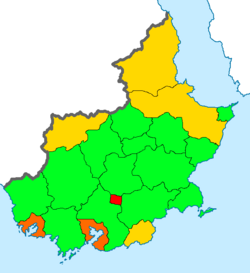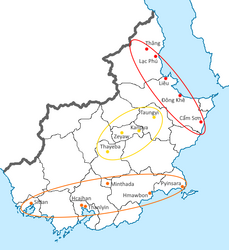Pyinthar
This article is incomplete because it is pending further input from participants, or it is a work-in-progress by one author. Please comment on this article's talk page to share your input, comments and questions. Note: To contribute to this article, you may need to seek help from the author(s) of this page. |
People's Republic of Pyinthar | |
|---|---|
| Anthem: ကမ္ဘာမကျေ Kaba Ma Kyei "Till the End of the World" | |
 Location of Pyinthar in Abaria | |
 Subdivisional map of Pyinthar | |
| Capital and largest city | Hcajhan |
| Official languages | Pyinthari |
| Recognised regional languages | Thanhliênese Lanhsavanian |
| Ethnic groups (2022) | 62.8% Pyinthari 21.4% Thanhliênese 7.1% Lanhsavanian 5.6% Mylasian 2.6% Yinese 0.5% Other |
| Religion (2022) | 81.2% No religion 6.8% Gregorianism 4.7% Himayan 2.4% Sendou 4% Other |
| Demonym(s) | Pyinthari |
| Government | Unitary Arvidsenist one-party socialist republic under a totalitarian military junta |
• Chairman | Hla Htay |
| Moe Thiri | |
• Premier | Zaw Lin |
| Legislature | People's Assembly |
| History | |
| c. 200 BCE | |
| c. 1350 | |
| July 1758 | |
| 1 August 1899 | |
| 18 September 1941 | |
| 13 April 1968 | |
| Area | |
• Total | 443,322.5 km2 (171,167.8 sq mi) |
• Water (%) | 3.0 |
| Population | |
• 2022 estimate | |
• Density | 217.47/km2 (563.2/sq mi) |
| GDP (PPP) | 2022 estimate |
• Total | |
• Per capita | |
| GDP (nominal) | 2022 estimate |
• Total | |
• Per capita | |
| Gini (2022) | medium |
| HDI (2022) | medium |
| Currency | Shwé (ရွှေ/Ꞩ, PYS) |
| Time zone | UTC-5 (Pyinthari Standard Time, PST) |
| Date format | dd-mm-yyyy |
| Driving side | right |
| Calling code | +68 |
| Internet TLD | .py |
Pyinthar (Pyinthari: ပြိန်ထရ; PLCTS: Pyain-ṭhar; [pjɪ̀ɰ̃.tʰa̰]), officially the People's Republic of Pyinthar (Pyinthari: ပြည်သူ့ သမ္မတနိုင်ငံ ပြိန်ထရ; PLCTS: Pyi Thu Samma Da Nain Ngan Pyain-ṭhar), is a sovereign state located in Western Abaria. It shares its only land border with Yingok to the west and its other close neighbors are X and X to the east, with the Jade Sea being located along most of the coastline. It is the third-largest country by area in Abaria and has a population of about 96 million. The country's capital and largest city is Hcajhan. The country consists of 4 Autonomous States, 2 Urban Regions, 1 Federal Union Territory, and 14 Common Regions, altogether comprising a total land area of 443,322.5 km2 (171,167.8 sq mi).
Early civilizations in the area stemmed from the immigration of southern Yinese people between 1500 and 1000 BCE. These later developed into more sedentary societies that included the Pyinthari- and Thanhliênese-speaking city-states, many of which arose around the 2nd century BCE. These city-states persisted until around the 9th century CE when many formed various regional confederations, in a period known as the Three Kingdoms Period. Following the establishment of the Hcajhan Kingdom around 1050 CE, the Pyinthari culture, language and religions became the dominant forms within the region. The Hcajhan Kingdom fell to the Artuchids around the late 13th century, where it was later replaced by the 2nd Three Kingdoms Period, with the kingdoms of Kathaiwabha, Daghein, and Thiênh (from west to east respectively). By the 16th century, the Kathaiwabha had subsumed the two others, forming the Taungumein Kingdom, which reunified most of what had been under the domain of the Hcajhan Kingdom earlier on. After a brief war against Yingok the Taungumein Kingdom collapsed, giving way to the Gyadhao Kingdom in 1758, which formed the modern borders and culture of Pyinthar.
The Gyadhao Kingdom eventually collapsed due to internal socio-political strife, and a lengthy civil war ensued from the commencement of the Industrial Revolution and the introduction of foreign liberal ideals, and later combinationalist influences. With the overthrow of the monarchy in 1899, the country finally entered an unstable period of republicanism, with attempted coups in 1917, 1924, and 1927. During this period, various civil conflicts broke out, coalescing into the start of the 2nd Pyinthari Civil War that lasted from 1927 with the military seizure of power, to the 1941 coup that saw the military surrender to rebel forces. With this came the foundation of the Pyinthari Revolutionary Council (PRC) and it's "Pyinthari Way to Socialism," which involved isolationist, xenophobic, and autarkist policies. This dark age lasted until the Internationalist faction carried out a coup against the PRC in 1968, abolishing the PRC, establishing the "People's Assembly," and opening up the country internationally. While the coup was relatively well-received by the international community, it did very little to actually help the Pyinthari population as the government continues to carry out politically repressive practices and human rights abuses, in addition to an ongoing civil conflict commonly referred to as the 3rd Pyinthari Civil War.
Pyinthar consistently ranks amongst the lowest in its region, and internationally, in terms of human development and economic development; it is considered one of the least developed countries. The country is a member of both the Global Socialist League and the United Congress, as well as a signatory (but not a ratifier) of the Treaty of Hellnafjord. The country is very rich in natural resources such as jade, gemstones, oil, natural gas, teak, and other minerals, as well as also endowed with renewable energy, having one of the highest solar power potentials in its region. However, Pyinthar has suffered longstanding political instability, factional violence, corruption, poor infrastructure, and conflict, resulting in it being poorly developed. The income gap in Pyinthar is among the widest in the world, as a large proportion of the economy is controlled by cronies of the military junta. Since the 2010s, an estimated 1.2 million people have been displaced across Pyinthar due to various ongoing conflicts and insurgencies, with an estimated 4 million being in need of humanitarian assistance.
Etymology
The etymology of the word "Pyinthar" is believed to be derived from the ancient Pyinthari words Pyin (ပြိန်) and Thar (ထရ). Pyin suggested a sort of connection, union, or harmony, with Thar implying a further sense of grandeur or significance. Over time, it is believed that these two words conjoined into some vague "Land/People of Harmony," though this particular etymology is disputed with one of Yinese origin.
Alternatively, others have linked it to the earlier Yinese readings of the early Pyin (or 平, pìng) people who inhabited much of central and southern Pyinthar between 1,000-500 BCE. This name is often expanded to 平土 (pìng tou), vaguely translating to "peaceful land" or "flat land." However, this view is quite niche amongst scholars, with the former often being the academically accepted etymology.
History
Prehistory
Archaeological evidence shows that Homo erectus lived in the region now known as Pyinthar as early as 750,000 to 800,000 years ago, with no more erectus finds after 75,000 years ago. The first evidence of Homo sapiens is dated to between 45,000 and 50,000 years ago with discoveries of stone tools in central Pyinthar. Evidence of Neolithic age domestication of plants and animals and the use of polished stone tools dating to sometime between 10,000 and 6,000 BCE has been discovered in the form of cave paintings in Bhatah-Pyin Caves.
The Bronze Age arrived c. 1500 BCE when people in the region were turning copper into bronze, growing rice and domesticating poultry and pigs; they were among the first people in the world to do so. Human remains and artefacts from this era were discovered in Thayeba District in the Inngyi Region. The Iron Age began around 500 BCE with the emergence of iron-working settlements in an area south of present-day Minthada. Evidence also shows the presence of rice-growing settlements of large villages and small towns that traded with their surroundings as far as Yingok between 500 BCE and 200 CE. Iron Age Pyinthari cultures also had influences from outside sources such as X and X, as seen in their funerary practices concerning child burials. This indicates some form of communication between groups in Pyinthar and other places, possibly through trade.
Pyinthari City-States
Around the second century BCE the first-known city-states emerged in central Pyinthar. The city-states were founded as part of the southward migration by the Yinese-speaking Pyin (or 平, pìng) people, the earliest inhabitants of Pyinthar of whom records are extant, from present-day Zhongdei Prefecture, Yingok. The Pyinthari culture was heavily influenced by trade with X, importing X as well as other cultural, architectural and political concepts, which would have an enduring influence on later Pyinthari culture and political organization.
Thanhliên Kingdom
The Thanhliên Invasion of Yingok (132 BCE) was a significant military campaign that led to the establishment of the Sin Dynasty throughout southern Yingok, marking the beginning of a century-long period of Thanhliênese rule over the region. The invasion, initiated by Thanhliênese forces in 132 BCE, resulted in the rapid defeat of Yinese defenses and the subsequent overthrow of the existing Yinese Chiu dynasty.
The Sin Dynasty, established by the Thanhliênese invaders, governed Yingok for over a century, from 132 BCE to 28 BCE. During this period, the dynasty implemented significant political and cultural changes, blending Thanhliênese and Yinese traditions. The Sin rulers consolidated their power through a combination of military prowess and strategic alliances, maintaining control over the vast and diverse territories of Yingok. This era is notable for the exchange of ideas, technology, and governance practices between the two cultures, leaving a lasting impact on the history and development of Western Abaria.
This period also influenced the later Three Kingdoms Period of Pyinthar, by establishing the Thanhliên confederation as a dominant and unified political and military power within Pyinthar.
Later developments
By the 9th century, several city-states had sprouted across the land: the Thanyeba in the central dry zone, Thanlyin along the southwestern coastline and the not-to-be-confused Thanhliên along the eastern littoral. The balance was upset firstly when the Pyinthari confederations came under repeated attacks from !Nanzhao between the 750s and the 830s. In the mid-to-late 9th century the Thanlyin people founded a small settlement at moder-day Hcajhan. It was one of several competing city-states until the late 10th century, when it grew in authority and grandeur.
These city-states were also foundational for the creation of the later three kingdoms, which formed almost exactly along the lines of the pre-existing confederations.


